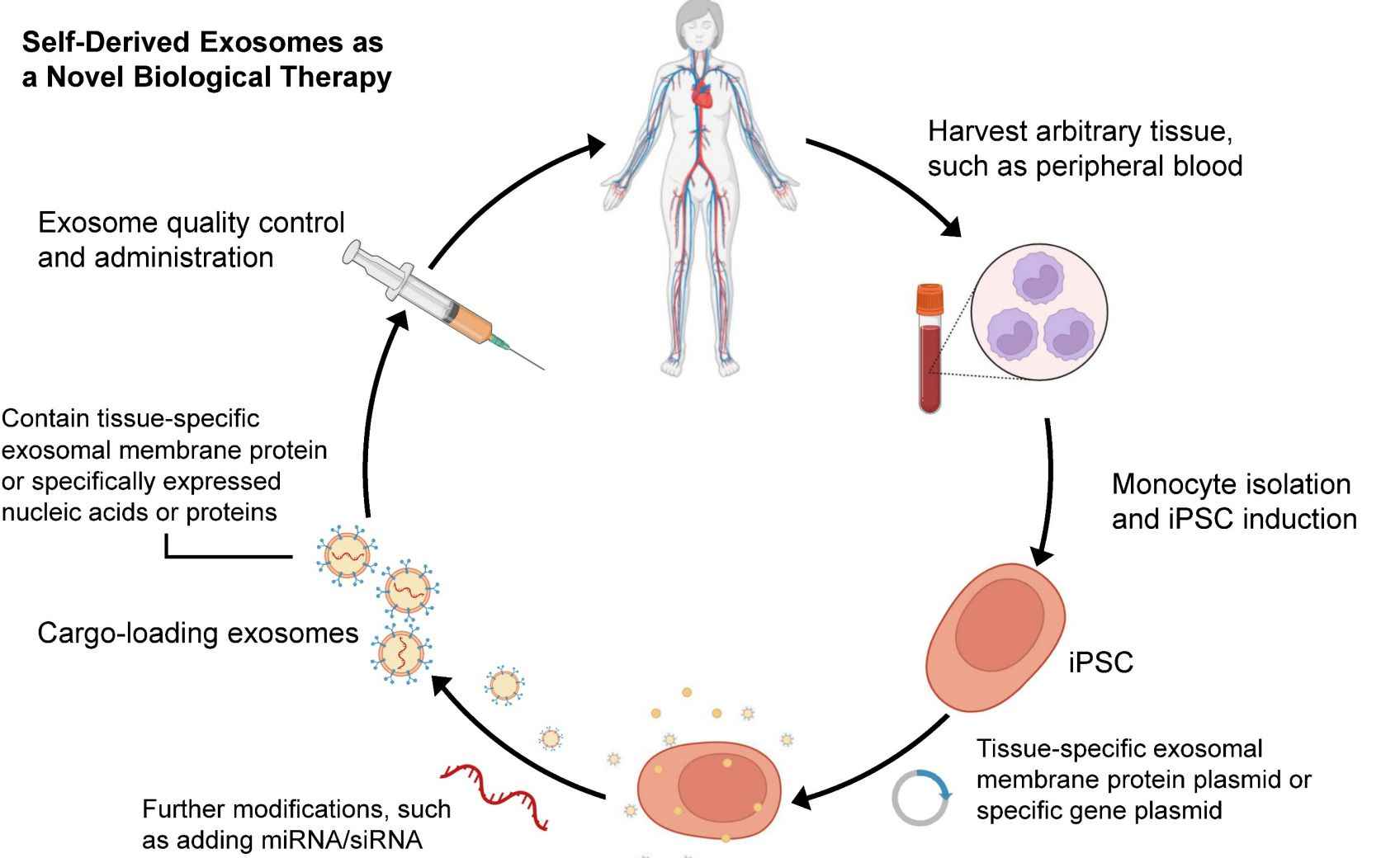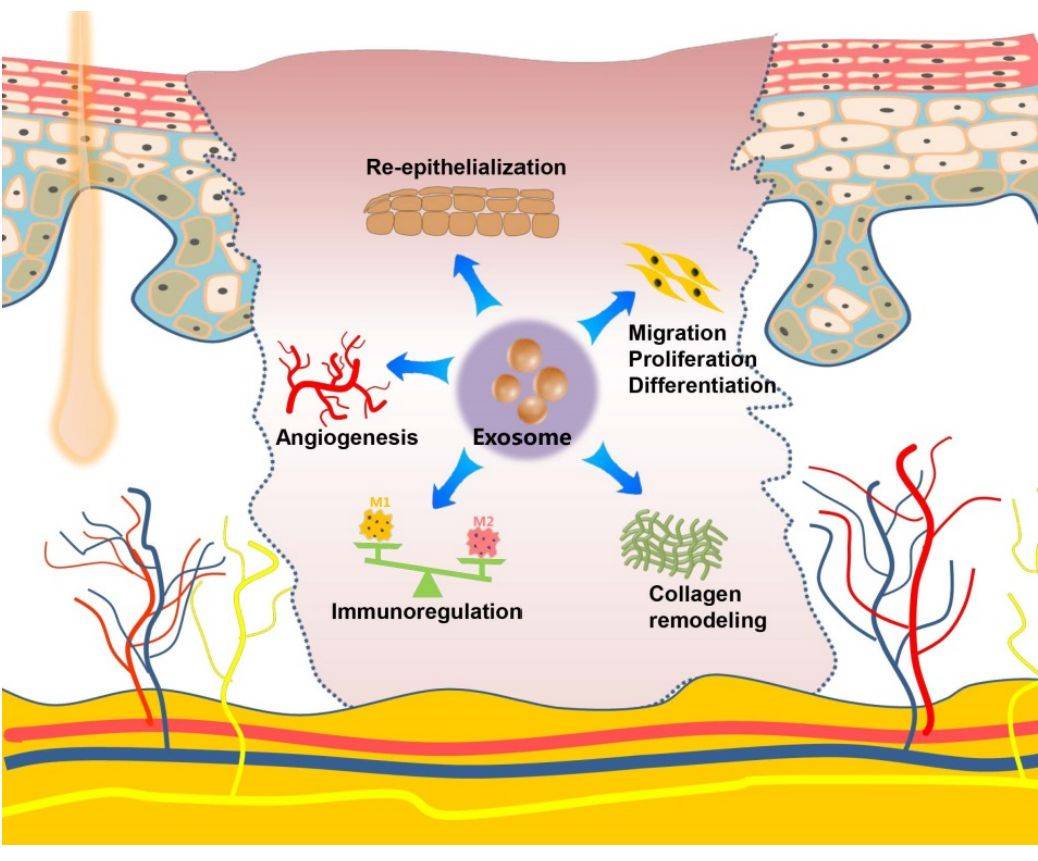Exosome Therapy in Skin Repair and Regeneration
Exosomes are small nanosized vesicles (30-150 nm) secreted from most cells with a phospholipid bilayer structure containing DNA, RNA, proteins, and other substances involved in intercellular communication. In recent years, it has been found that exosomes can participate in the process of skin tissue repair and regeneration. By promoting the proliferation and migration of skin cells, facilitating neovascularization, and regulating the immune response, exosomes can promote wound healing and skin regeneration, providing a new strategy for further cell-free therapy.
What is Exosome Therapy that Can be Used for the Repair and Regeneration of Skin?
Exosome therapy is a rapidly growing field in regenerative medicine that shows great potential in repairing skin damage. This therapeutic approach primarily involves the use of exosomes derived from adult stem cells (usually from umbilical cord tissue, bone marrow, or adipose tissue) to repair damaged or diseased tissue. Special attention has been given to Umbilical. In the context of regenerative medicine, MSC-derived exosomes have been the subject of extensive research due to their potential therapeutic applications. These MSC-derived exosomes have been shown to have functions such as promoting tissue regeneration, modulating immune responses, and enhancing the healing process.
 Figure 1. Production of autogenous exosomes as novel biodiagnostic agents. (Yang G, et al., 2023)
Figure 1. Production of autogenous exosomes as novel biodiagnostic agents. (Yang G, et al., 2023)
Advantages of Stem Cell-derived Exosomes over Stem Cells
Good safety - Exosomes do not express MHC class I or II antigens. Exosomes are non-self-replicating, reducing the risk of medical tumor formation. The use of exosomes for tissue repair can avoid the risk of immune rejection, vascular obstruction, mutation, and tumor formation, thus greatly improving safety.
Easily stored and transported - The isolated exosomes can be stored at -80℃ for a long period and maintain biological activity. The outer membrane of exosomes can protect its contents from degradation by RNA enzymes.
High efficiency - Exosomes are small in size and can be directly taken up by cells to affect the function of target cells, which improves the efficiency of action.
No ethical restrictions - As a subcellular structure secreted by cells, exosomes have no relevant ethical restrictions in their application.
Wide range of sources - Exosomes can be extracted from the culture supernatant of various cells, various body fluids, and blood, which is a wide range of sources.
How do Exosomes Promote Skin Repair and Regeneration?
During the inflammatory phase, exosomes affect immune cells, thereby reducing the inflammatory response. During the proliferative phase, exosomes promote a pro-angiogenic environment and initiate extracellular matrix deposition by activating endothelial cells and fibroblasts. In the remodeling phase, exosomes alter the ratio of matrix metalloproteinases and tissue inhibitors for good wound healing.
 Figure 2. Role and mechanisms of exosomes in skin and wound healing. (Xing X, et al., 2020)
Figure 2. Role and mechanisms of exosomes in skin and wound healing. (Xing X, et al., 2020)
- Regulating the Inflammatory Response
Inflammation is the body's self-defense mechanism in response to harmful stimuli, yet chronic and inappropriate inflammatory responses can lead to delayed wound healing. Researchers have found that exosomes secreted by human umbilical cord mesenchymal stem cells (hUCMSC) can attenuate excessive inflammatory responses induced by severe burns. It was found that hUCMSC-Exo reduced the total number of leukocytes and blocked the release of inflammatory factors. It was demonstrated that miR-181c in hUCMSC-Exo has a key role in regulating burn-induced inflammation.
- Regulation of Fibroblast Proliferation and Differentiation
Fibroblasts are the major cellular component of loose connective tissue and differentiate from embryonic mesenchymal cells. Fibroblasts are the main cells in the normal skin dermis and are important in wound repair, depositing collagen and elastic fibers from the extracellular matrix (ECM) in the connective tissue and stimulating wound healing. Studies have shown that human induced pluripotent stem cell mesenchymal stem cell (iPSC-MSC) exosomes can increase collagen secretion by promoting the proliferation and migration of endothelial cells and fibroblasts, thereby improving the rate of skin wound healing.
- Promoting Neovascularization
For wound repair, angiogenesis is an extremely important physiological role, which can transport oxygen, nutrients, immune cells, etc. to the site of injury and thus promote the proliferation of skin-associated cells and the deposition of extracellular matrix. Studies have shown that menstrual blood mesenchymal stem cell (MenSC) exosomes promote skin wound repair by inducing macrophage polarization, inhibiting inflammation, and upregulating vascular endothelial growth factor A to promote neovascularization.
- Inhibition of Scar Formation
Scarring not only affects the appearance but also scar tissue contracture can trigger limb dysfunction or even deformity. Studies have shown that adipose-derived mesenchymal stem cell (ADSC) exosomes can promote collagen type I and III production in the early stage of wound healing, and inhibit the expression of collagen in the late stage of healing, reducing collagen deposition thus inhibiting the formation of keloid scars.
Our Services and Products
Creative Biostructure is a pioneering biotechnology company dedicated to harnessing the extraordinary regenerative potential of stem cell-derived exosomes to repair and rejuvenate skin. Our team of leading experts in the field of exosome biology has developed innovative techniques to isolate and characterize the unique substances of these extracellular vesicles.
| Cat No. | Product Name | Source |
| Exo-SC01 | HQExo™ Exosome-PCS-500-011 | Exosome derived from human pre-adipose derived mesenchymal stem cell (PCS-500-011) |
| Exo-SC03 | HQExo™ Exosome-hTERT | Exosome derived from hTERT-immortalized Mesenchymal Stem Cell |
| Exo-SC04 | HQExo™ Exosome-MSC | Exosome derived from Xeno-Free Human Mesenchymal Stem/Stromal Cells and Media |
| Exo-SC02-1 | HQExo™ Exosome-PCS-500-012 | Exosome derived from human bone marrow-derived mesenchymal stem cell line (PCS-500-012) |
| Exo-SC02-2 | HQExo™ Exosome-Pla-MSC | Exosome derived from human placental derived mesenchymal stem cell |
| Explore All Exosomes Isolated from Stem Cell Lines | ||
By providing our clients with high-quality, well-characterized stem cell-derived exosome products, we enable researchers and clinicians to explore the various applications of these nanoparticles in skin tissue engineering, wound healing, scar reduction, and anti-aging therapies. If you are interested in our products and services, please feel free to contact us for a formal quote.
References
- Yang G, et al. Exosomes and Their Bioengineering Strategies in the Cutaneous Wound Healing and Related Complications: Current Knowledge and Future Perspectives. Int J Biol Sci. 2023. 19(5): 1430-1454.
- Xing X, et al. Emerging role of exosomes in craniofacial and dental applications. Theranostics. 2020. 10(19): 8648-8664.
- Prasai A, et al. Role of Exosomes in Dermal Wound Healing: A Systematic Review. J Invest Dermatol. 2022. 142(3 Pt A): 662-678. e8.